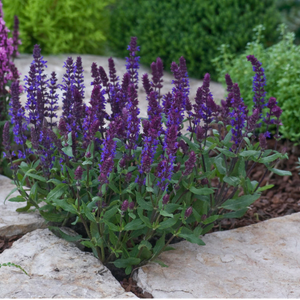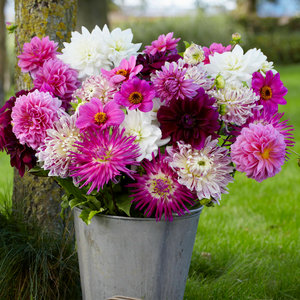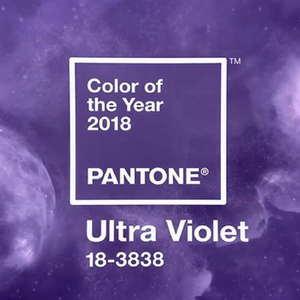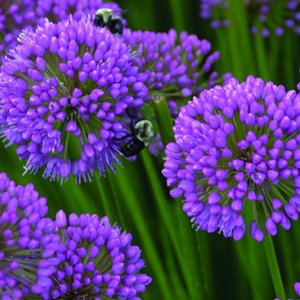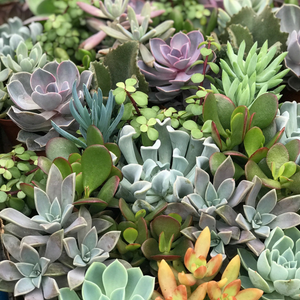News

Hardy Salvias are a Hit with Gardeners and Pollinators
From tropical forests to high-deserts and urban landscapes, Salvias are among the most common ornamental and culinary plant species you will find.
Although its name is derived from the Latin salvere, meaning to heal or good health, this moniker undoubtedly refers to the common herb Sage (Salvia officinalis) and not the ornamental Salvias we find flowering in our gardens. All Salvia are in the mint family Lamiacea and are cousins to landscape favorites such as Nepeta (Catmint) and Monarda (Beebalm). Indeed, many Salvia species reveal their history through their minty fragrance contained in their leaves. There are more than one thousand species in the genus; however, most are not hardy in northern gardens. This article focuses on the hardy types.
Hardy Salvia History
English botanist George Bentham did the first extensive documentation of this genus in 1836. One fascinating characteristic of Salvia flowers is that they contain a trigger mechanism that deposits pollen on the back side of visiting bees. This pollen then becomes transferred to female Salvia flowers that share the same receptive flower parts encouraging pollination among the same or similar species. The beautiful Salvia we find in our modern gardens originates from plants found in the wooded elevations of Eurasia. The most common hardy species are S. nemorosa and S. pratensis and the many hybrids derived such as S. x sylvestris and S. x superbum. Today, we typically refer to the entire class of these hybrids as S. nemorosa (nemorosa from the Latin ‘of woods’) for simplicity and the reason why we commonly refer to these hardy plants and Woodland Sage. Interestingly, all plants with the common name of Sage are Salvia, but we reserve the true genus name for ornamental rather than culinary species. The Sage you keep in your kitchen is actually Salvia too, and it can also be winter hardy in the north; however, they have lesser ornamental value.
Key Cultivars
Much of the early work in hardy salvia breeding was done by German plantsman Ernst Pagels who is credited with breeding varieties ‘Blauhugel’ (Blue Hill) and ‘Schneehugel’ (Snow Hill) shortly after the Second World War. Both of these are still in commercial cultivation and are found in garden centers during spring and summer.
Today, there are several hundred varieties of hardy garden Salvia from which to choose. Likely the most common and well-known cultivar, also a product of innovative German breeding is ‘Mainacht’ (MayNight). Named Perennial Plant of the Year by the Perennial Plant Association in 1997, May Night remains a favorite among landscapers for its abundance of indigo blue flowers and pest and disease resistance. Other standards include the upright, dark-stemmed variety ‘Caradonna’ and the dark purple cultivar ‘Ostfriesland’ (East Friesland). These tried-and-true classics are being replaced slowly with exciting new varieties from flower breeders in the United States and Europe. Award-winning cultivars such as ‘Blue Marvel’ and ‘Rose Marvel’ present extra-large flowers and provide a much longer flowering window. Newcomer ‘April Night’ is earlier to flower, as the name suggests, and is especially popular with southern gardeners. ‘New Dimension’, ‘Bordeau’ ‘Salute’ and ‘Swifty’ are all new introductions that are bred for improved garden performance. Of interest to the category, breeders are hybridizing S. nemorosa and S. pratensis to provide plants with more open and airier flower presentation. Examples include the Fashionista™ series and Salvia ‘Blue by You’.
Care and Cultivation
Hardy Salvia like S. nemorosa are considered to be care-free and easy to manage in the garden. They can be in place for years without a need for dividing. They are also a favorite of pollinators like bees and hummingbirds. As a member of the Mint family, their leaves are not on the preferred forage list of deer and rabbits and considered to be a great garden addition where these creatures are a nuisance. Be sure to plant in a location where they will receive at least one-half day of direct sunlight, as this will provide an environment that encourages the highest degree of flowering. Salvia prefers soils rich in organic matter, so it may be necessary to add compost, peat moss or topsoil to your sandy or heavy clay soil before planting. Once established in the garden, Salvia is quite drought tolerant and require watering only when other landscape shrubs such as Hydrangea show signs of wilting. To maintain healthy green growth, plan on fertilizing you Salvia plants when they emerge from dormancy in the spring and once again in early summer. Applying a balanced fertilizer such as 15-15-15 according to label directions will do the trick.
Many gardeners experience only one spring flowering display from Salvia because they are unaware that these garden beauties can be encouraged to rebloom several times during the summer and well into fall. Once the first flush of flowers has finished and the flower stems have turned brown, cut the plants back aggressively to about one-third their original size. Doing this causes the Salvia plants to push up new shoots from the root system, and you will be rewarded with a new flush of flowers in four to six weeks. Repeat this process, and it’s possible you may see as many as three or more full cycles of flowering in a single season. Remove all Salvia foliage after it turns brown in the fall to promote healthy new growth the following spring.
Article provided by the National Garden Bureau
- Kristin Ego

Living Coral - Pantone Colour of the Year for 2019
CARLSTADT, N.J., December 6, 2018 – Pantone, provider of professional color standards and digital solutions for the design industry, today announced PANTONE 16-1546 Living Coral as the Pantone Color of the Year 2019, an animating and life-affirming shade of orange with a golden undertone. We get energy from nature. Just as coral reefs are a source of sustenance and shelter to sea life, vibrant yet mellow PANTONE 16-1546 Living Coral embraces us with warmth and nourishment to provide comfort and buoyancy in our continually shifting environment.

In reaction to the onslaught of digital technology and social media increasingly embedding into daily life, we are seeking authentic and immersive experiences that enable connection and intimacy. Sociable and spirited, the engaging nature of PANTONE 16-1546 Living Coral welcomes and encourages lighthearted activity. Symbolizing our innate need for optimism and joyful pursuits, PANTONE 16-1546 Living Coral embodies our desire for playful expression.
Representing the fusion of modern life, PANTONE Living Coral is a nurturing color that appears in our natural surroundings and at the same time, displays a lively presence within social media. “Color is an equalizing lens through which we experience our natural and digital realities and this is particularly true for Living Coral,” said Leatrice Eiseman, Executive Director of the Pantone Color Institute. “With consumers craving human interaction and social connection, the humanizing and heartening qualities displayed by the convivial Pantone Living Coral hit a responsive chord.”
PANTONE 16-1546 Living Coral emits the desired, familiar and energizing aspects of color found in nature. In its glorious, yet unfortunately more elusive, display beneath the sea, this vivifying and effervescent color mesmerizes the eye and mind. Lying at the center of our naturally vivid and chromatic ecosystem, PANTONE Living Coral is evocative of how coral reefs provide shelter to a diverse kaleidoscope of color.
“Color enhances and influences the way we experience life,” said Laurie Pressman, Vice President of the Pantone Color Institute. “As a shade that affirms life through a dual role of energizing and nourishing, PANTONE 16-1546 Living Coral reinforces how colors can embody our collective experience and reflect what is taking place in our global culture at a moment in time.”
In Social Media
An organic shade, Living Coral is striking in digital mediums, evoking the same inspirational feeling ignited by our natural surroundings. Living Coral’s vibrancy and buoyancy captivates our attention in social media and digital design.
In Fashion and Accessories
Living Coral inspires experimentation and playful expression in both men’s and women’s street and runway styles. The warm shade suggests comfort and positivity in simple color stories, but becomes more explorative and effervescent in patterns, textures and even monochrome looks. An appealing accent shade, PANTONE Living Coral provides a striking contrast across the color spectrum.
In Beauty
As a life-affirming hue that complements all skin tones, PANTONE Living Coral brings natural color to beauty in blush, eye and lip. Uninhibited, playful looks are also emboldened by Living Coral, which, as the center of a kaleidoscope of color, encourages experimentation in beauty with palettes, textures, shimmers and sheens.
In Product Design
Living Coral is naturally suited for product across all ages and genders. Materials with texture and convivial colors such as PANTONE 16-1546 Living Coral appeal to our desire for products exhibiting humanizing and heartening characteristics.
In Interior Décor and Furnishings
When used as a bold statement in settings and décor, Living Coral fosters immersive experiences such as pop-up installations and interactive spaces, tied to a playful spirit. As a color linked to tactility and human connection, PANTONE Living Coral in shag rugs, cozy blankets and lush upholsteries create a warm, comforting and nurturing feeling in the home. With its ebullient nature, PANTONE Living Coral adds a dramatic pop of color to any room setting whether in decorative accessories, tabletop, or on the wall.
In Packaging Design
Living Coral is naturally ideal for packaging applications. Warm and welcoming, this life affirming shade invites us to reach out and touch.
Tribute Portfolio x Pantone Color of the Year
Among the joyful pursuits that Living Coral symbolizes, travel tops the list - often creating experiences that enable human interaction and social connection. In celebration of Living Coral as the 20th Pantone Color of the Year, Pantone has partnered with Tribute Portfolio, Marriott International’s newest collection of independent and characterful hotels, to create a first-of-its-kind pop-up pantry that will allow people to experience an immersive tribute to color at select hotels around the world. Together, Tribute Portfolio and Pantone will introduce a series of interactive Pantone pantries in indie-spirited and creative communities around the world, beginning at Art Basel Miami at the Royal Palm South Beach Miami Resort and then traveling to The Alida Hotel in Savannah, Georgia and The Slaak Rotterdam, in The Netherlands next year.
Adobe Stock x Pantone Color of the Year 2019
For the second year in a row, Pantone has partnered with Adobe Stock to offer a curated Color of the Year collection to inspire and assist the creative community. Living Coral illustrates a natural, yet dynamic and energizing tone that is perfect for designers across verticals looking to energize and enliven creative elements with a softer edge. With more than 125 million visual assets, Adobe Stock is an amazing resource for creatives to seek visual inspiration and creative development.
Material ConneXion, a SANDOW company & Pantone
Across the Design industry, effectively bringing PANTONE 16-1546 Living Coral to life in product design requires consideration of both color and the material to which it will be applied. To underscore the relationship between color and material, and increase efficiencies within the design process, Pantone has partnered with Material ConneXion, a global materials and innovation consultancy. By working with Material ConneXion, designers and suppliers can source the solutions that will meet consumer demands and deliver on their design vision while also supporting their business.
Limited Edition Pantone Color of Year 2019 Guides
In celebration of the 20th anniversary of the Pantone Color of the Year announcement, special collections of Pantone Formula Guides and Fashion, Home + Interiors Color Guides will be available for a limited time. Guides will feature commemorative Color of the Year covers, information on the 2019 selection and history of past Colors of the Year enclosed within the guide.
Pantone Color of the Year 2019 Formula Guides ($160) for graphic, print and packaging designers and Fashion, Home + Interiors Color Guides ($205) for fashion and product designers, are available in limited quantities from Pantone.com and through authorized distributors worldwide.
About the Pantone Color of the Year
The Color of the Year selection process requires thoughtful consideration and trend analysis. To arrive at the selection each year, Pantone’s color experts at the Pantone Color Institute comb the world looking for new color influences. This can include the entertainment industry and films in production, traveling art collections and new artists, fashion, all areas of design, popular travel destinations, as well as new lifestyles, playstyles, and socio-economic conditions. Influences may also stem from new technologies, materials, textures, and effects that impact color, relevant social media platforms and even up-coming sporting events that capture worldwide attention. For 20 years, Pantone’s Color of the Year has influenced product development and purchasing decisions in multiple industries, including fashion, home furnishings, and industrial design, as well as product, packaging and graphic design. Past selections for Color of the Year include:
- PANTONE 18-3838 Ultra Violet (2018)
- PANTONE 15-0343 Greenery (2017)
- PANTONE 15-3919 Serenity and PANTONE 13-1520 Rose Quartz (2016)
- PANTONE 18-1438 Marsala (2015)
- PANTONE 18-3224 Radiant Orchid (2014)
- PANTONE 17-5641 Emerald (2013)
- PANTONE 17-1463 Tangerine Tango (2012)
- PANTONE 18-2120 Honeysuckle (2011)
- PANTONE 15-5519 Turquoise (2010)
- PANTONE 14-0848 Mimosa (2009)
- PANTONE 18-3943 Blue Iris (2008)
- PANTONE 19-1557 Chili Pepper (2007)
- PANTONE 13-1106 Sand Dollar (2006)
- PANTONE 15-5217 Blue Turquoise (2005)
- PANTONE 17-1456 Tigerlily (2004)
- PANTONE 14-4811 Aqua Sky (2003)
- PANTONE 19-1664 True Red (2002)
- PANTONE 17-2031 Fuchsia Rose (2001)
- PANTONE 15-4020 Cerulean (2000)
The color selected as our Pantone Color of the Year 2019 was taken from the Pantone Fashion, Home + Interiors Color System, the most widely used and recognized color standards system for fashion, textile, home, and interior design.
For more information on the Pantone Color of the Year for 2019, please visit www.pantone.com/color-of-the-year-2019.
About The Pantone Color Institute™
The Pantone Color Institute is the business unit within Pantone that highlights top seasonal runway colors, forecasts global color trends, advises companies on color for product and brand visual identity. Through seasonal trend forecasts, color psychology, and consultative color consulting, the Pantone Color Institute partners with global brands to leverage the power, psychology, and emotion of color in their design strategy.
About Pantone
Pantone provides a universal language of color that enables color-critical decisions through every stage of the workflow for brands and manufacturers. More than 10 million designers and producers around the world rely on Pantone products and services to help define, communicate and control color from inspiration to realization – leveraging advanced X-Rite technology to achieve color consistency across various materials and finishes for graphics, fashion and product design. Pantone Standards feature digital and physical color specification and workflow tools. The Pantone Color Institute™ provides customized color standards, brand identity and product color consulting as well as trend forecasting inclusive of Pantone Color of the Year, Fashion Runway Color Trend Reports, color psychology and more. Pantone B2B Licensing incorporates the Pantone Color System into different products and services, enabling licensees to communicate and reproduce approved Pantone values and improve efficiencies for their users. Pantone Lifestyle brings color and design together across apparel, home, and accessories. Connect with Pantone on Instagram, Facebook, Pinterest, LinkedIn.
- Kristin Ego
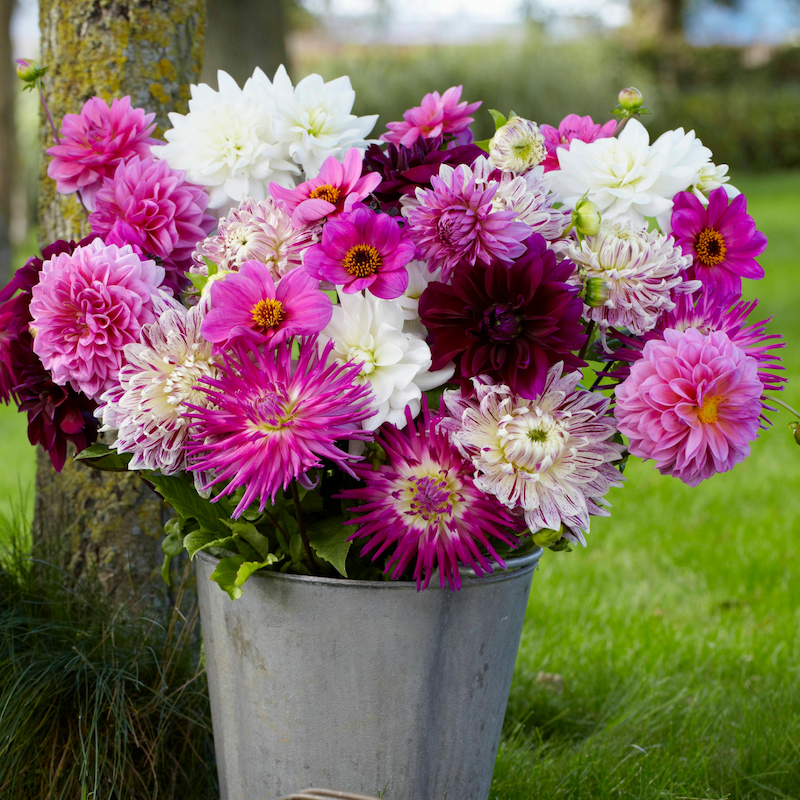
Delightful Dahlias
Did you know that the dahlia is the national flower of Mexico?
The native dahlias found in the mountains of Mexico and Guatemala are the genetic source for the modern hybrid dahlias we grow today. While busy conquering the Aztec nation, 16th-century Spanish conquistadors pursued numerous side explorations that led to the discovery of the New World plant life. Botanists accompanying the soldiers discovered what is sometimes referred to as the tree dahlia (D. imperialis). The hollow stems of these plants, some growing to over 20 feet, were often used for hauling water or as an actual source of water to traveling hunters. In fact, the Aztec name for “tree dahlias” was “acocotli” or “water-cane.”
About 200 years passed before dahlia seeds, roots, and plants found their way to Spain and other parts of Europe. The Madrid Botanical Gardens named the genus for Andreas Dahl, a Swedish botanist, and student of Carl Linnaeus. Initial breeders of dahlias were more interested in the dahlia as a food source since the blooms at that time were not particularly noteworthy.
In 1872 a new box of dahlia roots was sent from Mexico to Holland and the only surviving tuber produced a brilliant red bloom with petals that were rolled back and pointed. Immediately dahlias regained their place on the benches of plant breeders who began to successfully combine this new variety (D. juarezii) with parents of early varieties. These progenies have served as the parents of today’s hybrids. Breeders today propagate new cultivars using various techniques and creating fantastic new colors, shapes and plant habits that perform well in the garden.
Dahlia’s family
Dahlia is a genus of tuberous plants that are members of the Asteraceae (or Compositae) plants; related species include the sunflower, daisy, chrysanthemum, and zinnia. There are many species of dahlia in a range of colors and forms with hybrids commonly grown as garden plants. The flower varies in size and form. Each flower can be small or large, ranging from 2” in diameter to up to 15 inches. The largest flower form is informally known as a “dinner plate” dahlia.
The American Dahlia Society (ADS) categorizes today’s dahlias into various groups based on size, form, and colour.
Getting dahlias
There are several ways to enjoy your first dahlia. Most garden centers, home improvement stores, and mail order sources sell dahlia tubers (a thick, underground stem or rhizome) as well as blooming potted plants. A tuber looks like a sweet potato that grows under the soil surface and sends up strong stems. Additionally, almost every dahlia society has tuber and plant sales and they welcome guests to those events.
When to plant
Your tubers can go directly into the ground in the spring when the ground is warm and there is little chance of frost. One good guideline is to plant at the same time as you would a tomato. If you want blooms as early as possible, you can start the tubers indoors in good light about a month before planting time. By starting early you could have a small plant ready to transplant at planting time.
Where to plant
Dahlias require a site with good drainage and partial to full sun. Mono-culture and combination containers are also an increasingly popular way to grow dahlias.
How to plant
Most dahlias need to be staked to avoid falling over at maturity. Best practice is placing the stake prior to planting to avoid damaging the tuber and roots system. Tomato cages can also be a simple approach to staking.
Plant the tuber according to the package directions with the “eye” on the tuber facing up. The eye is the point on the shoulder, or crown, of the tuber from which the plant grows.
If you are buying potted plant dahlias, simply transplant into a prepared garden bed or decorative containers.
Protecting your plants from pests
Small dahlia plants are susceptible to slug damage. It is a good idea to manually remove slugs or to protect them with a slug bait or traps.
Japanese beetles seem to enjoy dahlia blooms just when they are ready for a bouquet. One of the best methods of control is to manually remove the beetles and drop them into a bucket of soapy water.
If other insects such as earwigs, thrips, or aphids become a problem, and you want your blooms to be “perfect” then you might want to consider using an insecticidal soap.
Deer problem? Dahlias are low on the deer’s list of favorite foods. While dahlias are not “deer-proof,” they are deer resistant.
Watering and fertilizing
Dahlias do not need a lot of water; in fact, excessive watering early in the season can lead to rotting. Best practice is to monitor the soil moisture especially if the local rainfall is less than one inch per week. In containers, Dahlias will require more water because of their limited soil volume.
Dahlias will generally benefit from regular treatments with a water-soluble or granular fertilizer. Traditional wisdom for dahlias is to treat with a high nitrogen fertilizer early in the season and then transition to a bloom-type fertilizer (lower nitrogen and higher in potassium and potash) in the middle part of the season. You should stop fertilizing later in the season or about the first of September.
End of the season
Go to the American Dahlia Society for this article on how to harvest and store your tubers.
Thank you to the National Garden Bureau and the American Dahlia Society for information in this article.
- Kristin Ego
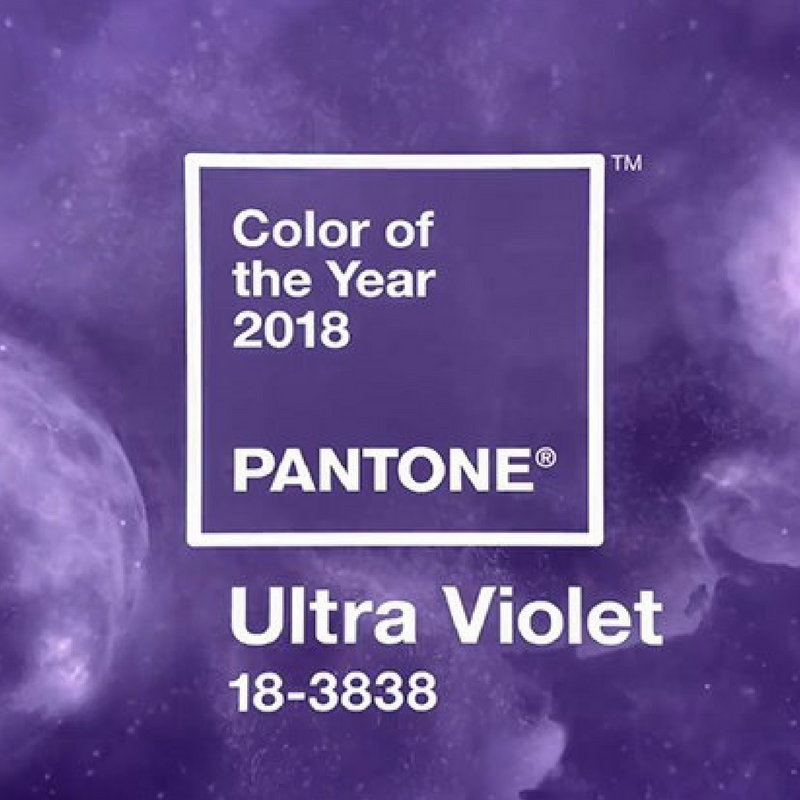
Pantone features Ultra Violet for 2018
As part of a yearly tradition renowned across several design-centric and creative industries, Pantone has announced that Ultra Violet will be its 2018 Color of the Year. Each year's decision is based on comprehensive trend analysis and a specific theme - this year, Pantone looks out toward the unknown and undiscovered."Complex and contemplative, Ultra Violet suggests the mysteries of the cosmos, the intrigue of what lies ahead, and the discoveries beyond where we are now," reads the announcement on Pantone's website. "The vast and limitless night sky is symbolic of what is possible and continues to inspire the desire to pursue a world beyond our own."
Pantone's Color of the Year selections are intended to be reflections of the current moods, fashions and foremost concepts in the world at the time. In selecting Ultra Violet, Pantone pays homage to the artistic influences of recently departed cultural icons such as David Bowie and Prince, as well as guitar legend Jimi Hendrix, whose usage of Ultra Violet shades are still remembered today as expressions of their individuality.
"Enigmatic purples have also long been symbolic of counterculture, unconventionality, and artistic brilliance," the announcement by Pantone reads. "Nuanced and full of emotion, the depth of PANTONE 18-3838 Ultra Violet symbolizes experimentation and non-conformity, spurring individuals to imagine their unique mark on the world, and push boundaries through creative outlets."
Other brands, such as Sherwin Williams, also offer their visions of prominent colors every year. This year, the paint producer named Oceanside, a rich, blue/green tone, as its Color of the Year for 2018.
Last year, Pantone was inspired by nature to select Greenery as its 2017 Color of the Year. For more information on Ultra Violet and previous selections for Color of the Year, visit Pantone's website.
- Kristin Ego
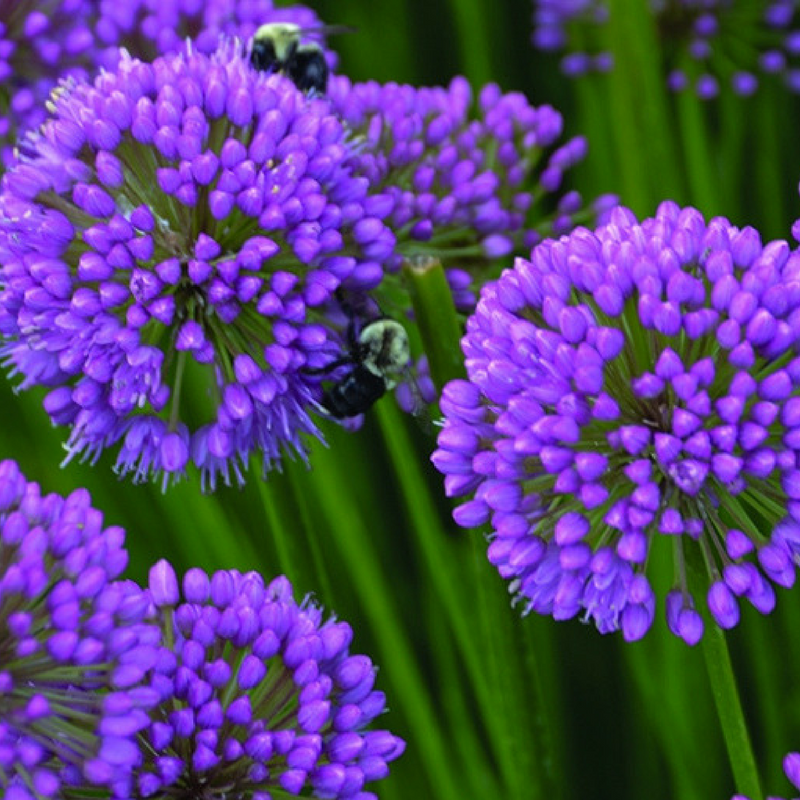
Allium 'Millenium' named 2018 Perennial of the Year
The Perennial Plant Association has awarded the title Perennial Plant of the Year® 2018 to Allium ‘Millenium’. This herbaceous perennial, relative to the common onion, is a workhorse of the late summer garden. Bred by Mark McDonough, horticulture researcher from Massachusetts, ‘Millenium’ was introduced through Plant Delights Nursery in 2000 where it has proven itself year after year earning rave reviews. ‘Millenium’ is spelled with one “n”, as registered, but is occasionally incorrectly listed with two “n”s. This cultivar is the result of a multigenerational breeding program involving Allium nutans and A. lusitanicum (formerly Allium senescens ssp montanum), selected for late flowering with masses of rose-purple blooms, uniform habit with neat shiny green foliage that remains attractive season long, and for its drought resistant constitution.
The genus Allium contains more than 900 species in the northern hemisphere, but is perhaps best known for a dozen or so species of culinary vegetables and herbs: onion, garlic, leeks, shallots, scallions, and chives. The genus is also known for a few dozen ornamentals that grow from bulbs and sport tall stems with big globe-shaped blooms in spring. The vast majority of the genus is little known and absent from horticulture, yet possesses significant ornamental potential.
Allium ‘Millenium’ has numerous virtues to add to the landscape setting. Growing best in full sun, each plant typically produces an upright foliage clump of grass-like, glossy deep green leaves reaching 10-15” tall in spring. In midsummer, two to three flower scapes rise above the foliage with each scape producing two or three showy two-inch spherical umbels of rose-purple florets that last as long as four weeks. The flower umbels are completely round (spherical), not domed or hemispherical as they are in some Allium species. They dry to a light tan often holding a blush of their former rose-purple color. While other alliums can look scraggly in the heat of the summer, ‘Millenium’ does not let the heat bother it! Easily grown in zones 4-9 (possibly zone 3) makes it a great perennial in many areas of the country. In very hot summer climates it does appreciate afternoon shade.
No serious pest problems have been reported. Leaf spot may occur in overcrowded growing conditions. Deer and rabbits leave ‘Millenium’ alone. Alliums are sometimes avoided due to their reseeding behavior. Fortunately ‘Millenium’ exhibits 50% reduced seed production, raising less concern for self-sown seedlings.
Allium ‘Millenium’ has a fibrous root structure forming an ornamental herbaceous clump easily propagated by division. Once in the garden, ‘Millenium’ can easily be lifted and divided in either spring or fall. Cut back foliage in late fall.
Pollinators will flock to Allium ‘Millenium’! Butterflies and bees will thank you for adding ‘Millenium’ to your garden. Pair with shorter goldenrods (Solidago sp.) such as ‘Little Lemon’ that reaches one and a half feet tall. Goldenrods are late summer pollinator magnets that will offer beautiful contrasting golden yellow blooms. Another late summer re-blooming companion perennial to consider is Oenothera fremontii ‘Shimmer’ with its low-growing silvery foliage adorned daily with large yellow flowers that open late afternoon and fade to an apricot color by morning. Being tap-rooted this evening primrose is well behaved, not creeping through the garden, for which, rhizomatous spreading evening primroses are famously known. Allium ‘Millenium’ looks great backed with the silver foliage of Perovskia atriplicifolia, Russian sage, or the native Scutellaria incana, downy skullcap, with its numerous spikes of blue flowers above trim green foliage. Or simply plant ‘Millenium’ en masse and enjoy the rose-purple display!
This low-maintenance dependable perennial will not disappoint! Blooming at a time when most of our garden begins to decline in the tired excess of the season, ‘Millenium’ offers much needed color. It is truly an all-season plant that offers attractive shiny foliage spring through summer and caps off the season with its crown of perfectly round rose-purple flower umbels!
Hardiness
USDA Zones 3 or 4 to 9
Light
Allium ‘Millenium’ grows best in full sun. In very hot climates partial shade may be best.
Soil
Grows best in well-drained soils.
Uses
Allium ‘Millenium’ is a perfect selection for full-sun gardens where its sleek structure can complement many other growth habits. Cut flowers retain a blush of their summer color.
Unique Qualities
Allium ‘Millenium’ is a butterfly magnet. The plant is interesting through multiple seasons for both foliage and large, gorgeous blooms. Reseeding is much less a problem than in other alliums.
Maintenance
Allium ‘Millenium’ is subject to no serious insect or disease problems. Deer and rabbits usually avoid ‘Millenium’.
Martha A. Smith, Horticulture Educator, University of Illinois Extension
Mark McDonough, Plant breeder/horticulture researcher, Massachusetts
- Kristin Ego
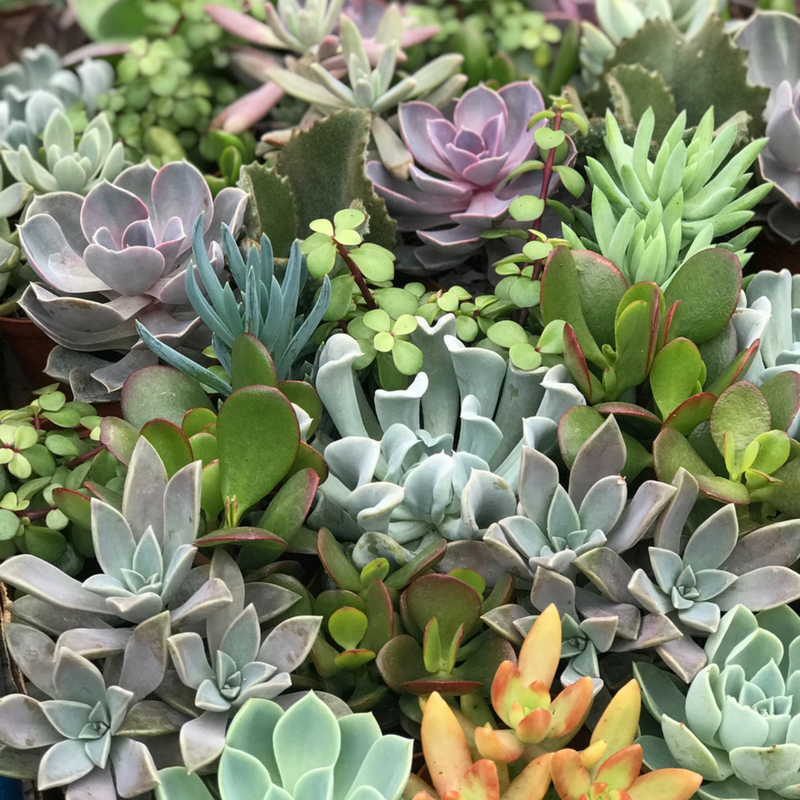
Savvy Succulents
Cacti and Succulents have definitely grown in popularity over the last decade. As more and more varieties become available they are increasingly in the spotlight. This is, of course, with good reason: not only are they easy to care for, but they can be showcased in so many ways!
Though often referred to as two distinct groups cacti actually belong to the succulent family. All cacti are succulents, yet cacti are a sub-species known by the presence of areoles (specialized sites where spines form) whereas other succulents have none.
The majority of cacti grow in deserts with low moisture, dry air, bright sunshine, good drainage and high temperatures. These desert-dwelling plants can survive for really long periods of time without rainfall. They get their moisture from dew or mist and store nutrients and moisture in their tissues.
The word “succulent” means “juicy.” Succulent plants have leaves or stems that are filled with juices, which is the stored water and nutrients that allow the plant to grow. These leaves allow the plant to withstand harsh conditions. Normally, these leaves have a glossy or leathery appearance, this texture actually helps protect them from moisture loss. Many succulents are also found in desert like conditions; however there are succulents which grow naturally in rainforests (such as a Christmas Cactus). These require semi-shade and humid conditions.
Most succulents and cacti require a lot of light. They are suitable for the sunniest of spots in your home. Be sure to turn the plants regularly so all sides of the plant get equal exposure.
If it is the wonderfully unique flowers you are after it is best to buy cacti that are already in flower because it often takes years for them to bloom. Before you buy check the plants over and make sure they are sound with no trace of rot or areas that are shriveled or dry. They should be just the right size for their pot and you should make sure that they are not exposed to drafts when you get them home.
Ensure they are planted in cactus or succulent soil which allows for good drainage. In Spring and Summer they will require a good soak, then allowed to dry in between waterings. In winter months they should be allowed to go completely dry, especially if they are in cool conditions as this allows the plants to go dormant. Most cacti and succulents like temperatures of 50-55F (10-13 C) in the winter.
During periods of active growth, cacti and succulents should be fed about once every three weeks. They should only be repotted once the roots completely fill their pot.
Cacti and succulents make great gifts, they are good for beginners or even the master gardener.
With all of the unique ways they can be planted, they are often used in home décor, and are great to give as a housewarming gift. Growing cacti and other succulent plants can be an addictive pastime, and many of the more difficult to grow varieties are considered a collectible.
Now is a great time to add a cacti or succulent plants to your home! With so many easy to care for varieties it is a great place for a novice to start and still great fun for the experienced indoor gardener.
- Kristin Ego
- Tags: echeveria planter succulents workshops


